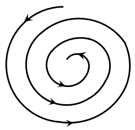Uniform Circular Motion
Uniform Circular Motion: Overview
This Topic covers sub-topics such as Centripetal and Centrifugal Force, Relation between Linear and Angular Velocity, Acceleration in Circular Motion, Resolution of Forces in Circular Motion and, Circular Motion with Variable Angular Acceleration
Important Questions on Uniform Circular Motion
Two particles of mass M and m are moving in a circle of radii R and r. If their time – periods are same, what will be the ratio of their linear velocities?
What is the linear velocity if the angular velocity vector is and position vector is ?
A car takes a round turn of radius with the velocity of . The centripetal force is:
A ball of mass attached to the end of a string of length is moving in a horizontal circle. The string will break if the tension is more than . What is the maximum speed with which the ball can be moved?
A body is whirled in a horizontal circle of radius 20 cm. It has an angular velocity of What is its linear velocity at any point on circular path
When a body moves with a constant speed along a circle
A particle of mass M is moving in a horizontal circle of radius R with uniform speed V. When it moves from one point to a diametrically opposite point, its :
Two blocks of mass and connected to each other by a massless inextensible string of length are placed along a diameter of a turn table. The coefficient of friction between the table and is while there is no friction between and the table. The table is rotating with an angular velocity of rad about a vertical axis passing through its centre . The masses are placed along the diameter of the table on either side of the centre such that the mass is at a distance of from . The masses are observed to be at rest with respect to an observer on the turn table. Calculate the frictional force on .
A hemispherical bowl of radius is rotating about its own axis (which is vertical), with an angular velocity . A particle of mass on the frictionless inner surface of the bowl is also rotating with the same . The particle is at a height from the bottom of the bowl.
Obtain the relation between and . What is the minimum value of needed, in order to have a non-zero value of ?
Three particles, each of mass are situated at the vertices of an equilateral triangle of side length . The only forces acting on the particles are their mutual gravitational forces. It is desired that each particle moves in a circle while maintaining the original mutual separation . Find the initial velocity that should be given to each particle and also the time period of the circular motion.
An electric line of force in the plane is given by the equation . A particle with unit positive charge, initially at rest at the point in the plane, will move along the circular line of force.
The tangential acceleration of the tip of a blade is and its centripetal acceleration is . Find the value of linear acceleration of the tip of the blade.
Why is centrifugal force considered as an imaginary force?
A body of mass is moving with speed along a circular path of radius . Now, the speed is reduced to and radius is increased to . For this change, initial centripetal force needs to he
A particle is moving in a circle of radius with a constant speed . Its average acceleration over the time when it moves over half the circle is :
Two identical particles each of mass go round a circle of radius under the action of their mutual gravitational attraction. The angular speed of each particle will be :
A child of mass is going round a merry-go-round that makes rotation in . The radius of the merry-go-round is . The centrifugal force on the child will be
A particle is moving on a spiral path as shown in the figure. The speed of particle remains constant.
In circular motion speed depends on angular position as . The value of as a function of time is
A car is moving with a speed of on a circular path of radius . Driver of car applies the brakes producing a uniform deceleration of. Then,
A) The centripetal acceleration of car just after applying the brake is 4 m/s².
B) The acceleration just after applying the brake is 5 m/s².
C) The acceleration is directed towards the centre just after applying the brake.
D) The angle between acceleration and velocity just after applying the brake is 127.

